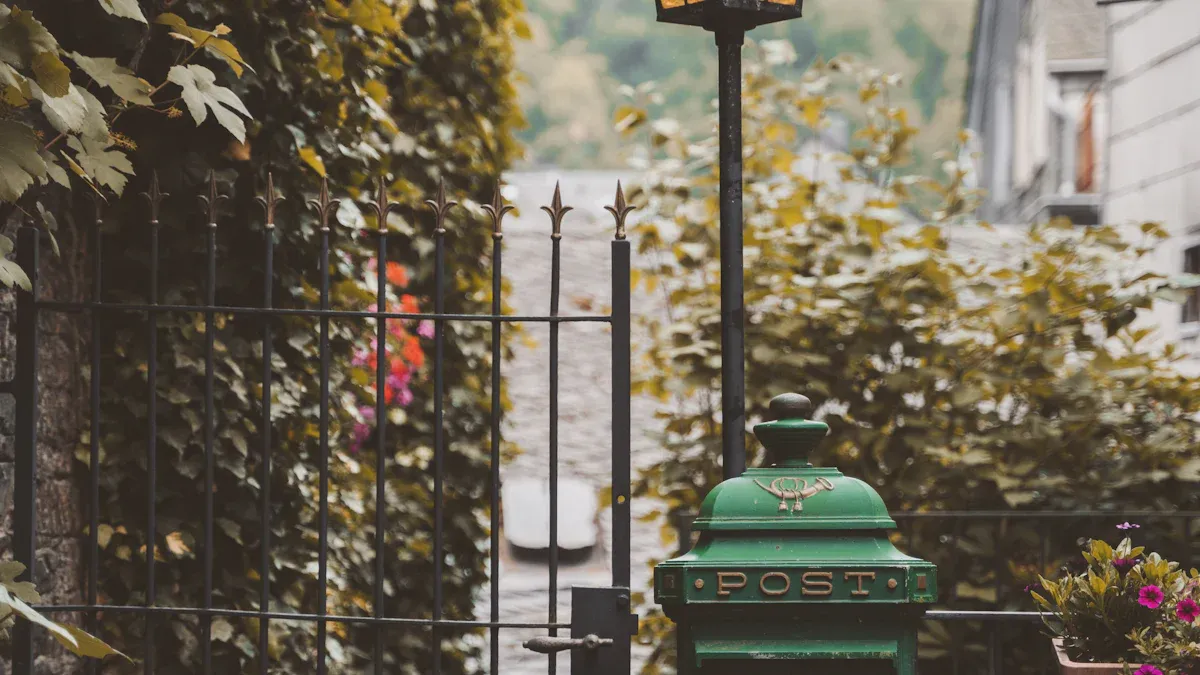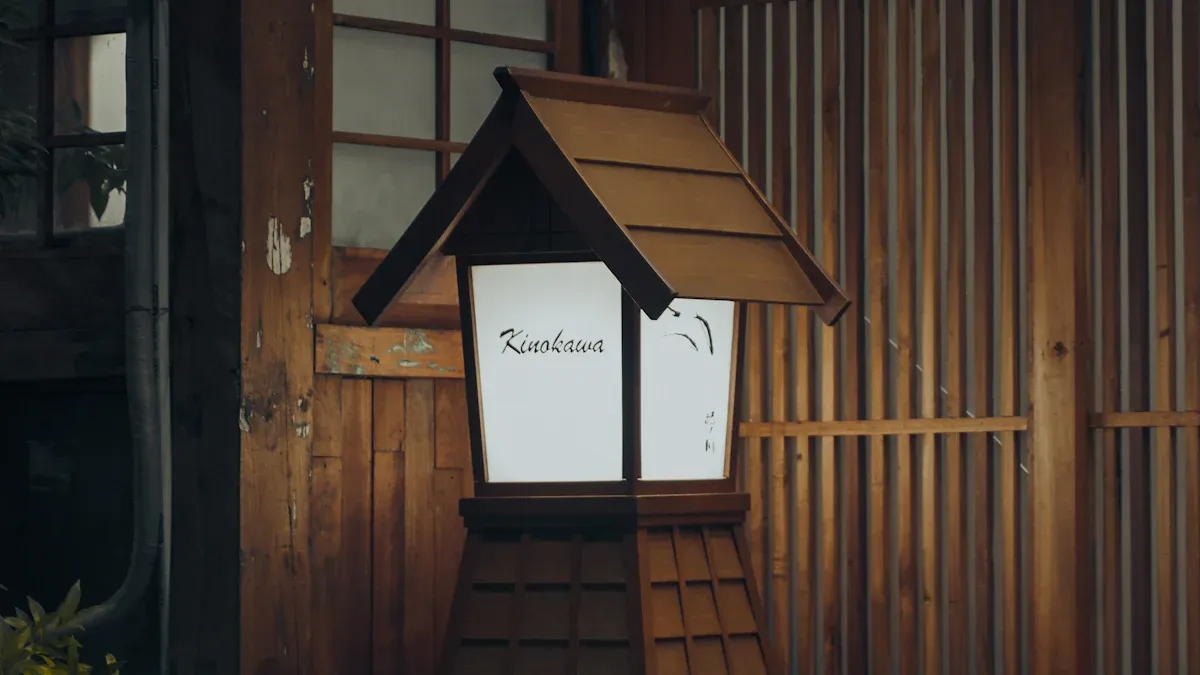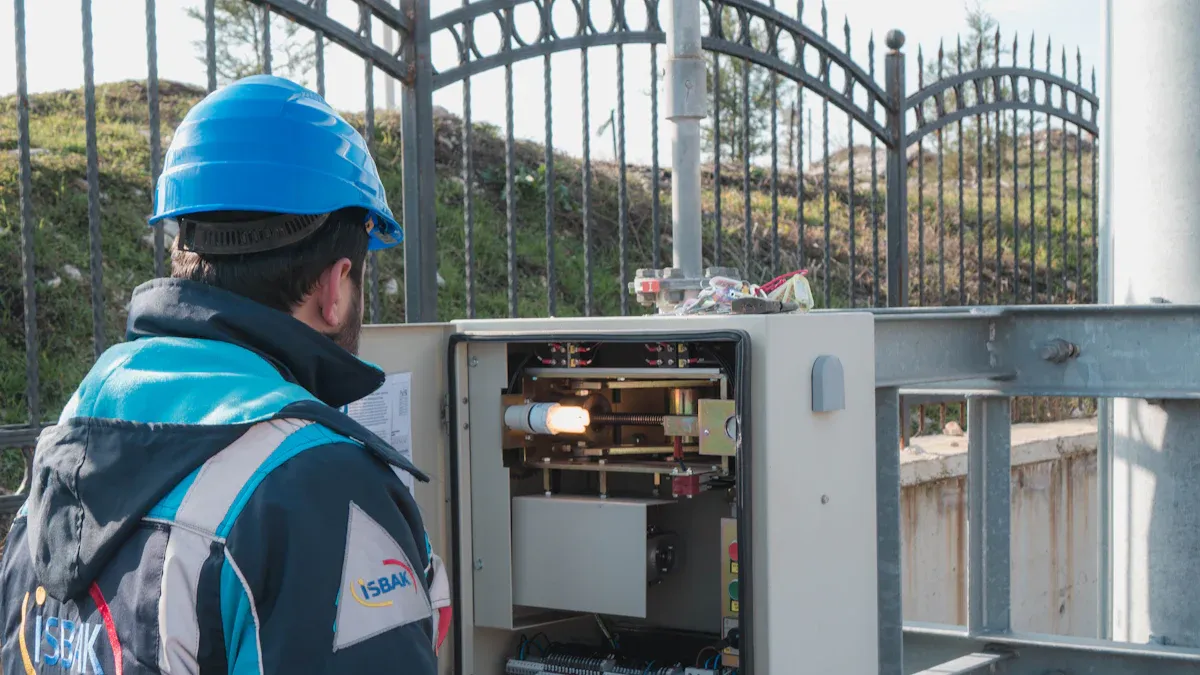Outdoor Light Boxes: Types, Installation, and Maintenance for All Weather Conditions

Outdoor light boxes help you light up outdoor areas. They keep spaces bright and safe. You need a weatherproof electrical box outside. It protects wires from rain and dust. It also keeps wires safe from hot or cold weather. Pick boxes made from strong materials like aluminum or high-grade plastic. These materials stop rust and corrosion.
Smart technology lets you check your lights from far away.
Adjustable mounting brackets make it easy to install.
If you set up and care for your system the right way, you make things safer. Your lights will work in any kind of weather.
Key Takeaways
Pick weatherproof outdoor light boxes. They keep your lights safe from rain, dust, and heat or cold.
Use strong materials like aluminum or good plastic. This helps the boxes last long and stops rust.
Clean and check your outdoor light boxes often. This keeps them working well and stops expensive fixes.
Follow safety rules and local laws when you put in outdoor lights. This makes sure your setup is safe and works right.
Think about using LED lights. They shine for a long time and use less energy.
Outdoor Light Boxes Overview

What Are Outdoor Light Boxes
Outdoor light boxes help protect and power lights outside. They keep wires safe from rain, dust, and changes in temperature. You can see them on patios or at busy stores. Outdoor light boxes let you use many kinds of outdoor lights. These include security lights, pathway lights, and accent lights. They help your lights work well and stay safe in any weather.
Here is a table that shows where people use outdoor light boxes:
Setting | Common Applications |
|---|---|
Residential | Outdoor Lighting Systems, Security Systems, Power Outlets |
Commercial/Industrial | Heavy Machinery Controls, Power Distribution Systems |
Outdoor light boxes are different from indoor boxes because they have special parts. You can see these parts in the list below:
Aluminum frame makes them strong and stops rust.
Full UL listing means they are safe.
Weather stripping keeps out water and dust.
Drain holes let water out.
UV-resistant lens protects the graphics.
Clear powdercoat finish keeps them looking new.
Hard-wiring helps them stay in place.
Extra space helps control moisture inside.
Internal bracing makes them strong in bad weather.
Security access stops people from tampering.
Polycarbonate lenses do not break easily.
No-glare lenses help you see better.
Benefits for All Weather
You need a weatherproof electrical box to keep your lights safe outside. These boxes protect wires from water, dust, and hot or cold weather. If you use the right box, you stop problems like rust and broken wires. This is very important if you live where it rains or snows a lot.
Weatherproof boxes have strong seals and special coatings. They work well in storms and help you save money on repairs. You get good lighting all year with a strong weatherproof box. This keeps your home or business safe and bright in every season.
Types of Outdoor Weatherproof Electrical Box
LED Outdoor Light Boxes
LED outdoor light boxes help you save energy and last a long time. They use less power but still shine bright. LED boxes can work for up to 50,000 hours. You will not need to change bulbs often. These boxes have strong seals to keep out rain, snow, and dust. You can use them for pathways, signs, or security lights.
Tip: Using LED outdoor weatherproof electrical box choices saves money on energy and cuts down on repairs.
Fluorescent Outdoor Light Boxes
Fluorescent outdoor light boxes give steady light for signs and big spaces. They cost less at first but do not last as long as LEDs. Most fluorescent lights work for 6,000 to 15,000 hours. You should check the seals and covers to keep them safe from weather. These boxes are good for places that need soft light and not too much brightness.
Here is a table that shows how long each lighting type lasts:
Lighting Type | Average Lifespan (Hours) |
|---|---|
LED | 50,000+ |
CFL | 6,000-15,000 |
Halogen | 2,000-4,000 |
Incandescent | 750-1,000 |
Solar Outdoor Light Boxes
Solar outdoor light boxes use sunlight to power your lights. They help you save money and are good for the planet. You do not need wires, so they are easy to put in. Solar boxes work best in sunny places. If it rains or snows a lot, they may not be as bright or last as long.
Advantages | Limitations |
|---|---|
Saves energy | Needs good weather |
Lowers costs | Costs more at first |
Good for the environment | Not as bright and may not last long |
Easy to set up and take care of |
Materials and IP Ratings
Look at the materials and IP ratings when you pick an outdoor weatherproof electrical box. The material helps the box last longer and stay strong. ABS plastic is light and does not rust. Polycarbonate is tough and stands up to sunlight. Metal boxes give the best protection in bad weather. IP ratings tell you how well the box keeps out water and dust. IP44 is good for patios and gardens. IP55 is better for busy outdoor places. IP65 and IP66 keep wires safe in very harsh weather.
Material Type | Properties | Best Use Case |
|---|---|---|
ABS Plastic | Light, strong, and does not rust. | Homes and mild weather. |
Polycarbonate (PC) | Very tough, blocks UV rays, and strong. | Stores and business places. |
Metal (Stainless Steel or Aluminum) | Best for stopping damage, does not rust. | Places that need lots of safety. |
IP44 | Good for gardens and patios with little rain. | Light outdoor use. |
IP55 | Stops dust and water jets better. | Busy outdoor areas. |
IP65/IP66 | Keeps out dust and strong water jets. | Hard weather and public places. |
There are many kinds of outdoor weatherproof electrical box choices. Each one has different features and strength. Pick the best box for your weather and needs.
Choosing the Right Outdoor Weatherproof Electrical Box
Safety and Durability Factors
When you pick outdoor light boxes, you want them to keep your home or business safe. You also want them to last a long time. The right outdoor weatherproof electrical box gives you both safety and good use. You should look at a few important things before you buy.
Size and Capacity: Pick a box that fits all your wires and devices. If the box is too small, it can cause safety problems.
Material: Choose between plastic and metal. Plastic boxes are light and do not rust. Metal boxes are strong and protect against bumps.
Number of Gangs: Make sure the box has enough spaces for your switches or outlets.
Ingress Protection (IP) Rating: Higher IP ratings mean better protection from dust and water.
Tip: Always check if the box has a UL or CE mark. These marks show the box meets safety rules.
Here is a table to help you compare plastic and metal boxes:
Criteria | Plastic Electrical Boxes | Metal Electrical Boxes |
|---|---|---|
Durability | Light and does not rust, but may break in very hot or cold weather. | Strong and lasts long, protects well from bumps. |
Weather Resistance | Does not carry electricity, but sun can damage it if not made for outside. | Moves heat away, but can rust if not treated. |
Safety Features | Lowers risk of electric shock. | Can carry electricity, needs special care to be safe. |
Weatherproofing | Needs to keep water out. | Must close tight to stop water and dirt. |
Maintenance | Check for sun damage and cracks. | Look for rust and make sure seals are good. |
You should also look for these things:
Material: Think about where you will use the box and how much weather it will face.
Weatherproofing: Make sure the box has seals and covers to keep out water and dust.
Safety: Look for ground screws and safe wiring layouts.
Installation and maintenance: Learn how to put in the box and check it often.
Safety and good use are most important. You want a box that keeps your wires dry and safe. You also want a box that stands up to rain, snow, and sun. If you pick the right outdoor weatherproof electrical box, you protect your property and save money on repairs.
Here are some common safety certifications and what they mean:
Certification | Significance |
|---|---|
UL (Underwriters Laboratories) | Shows the box meets safety rules for electrical use. |
CE (Conformité Européenne) | Means the box follows European safety and environmental rules. |
Weight and Weather Exposure Ratings
You need to think about how much weight your box can hold and how much weather it can handle. These ratings help you pick the best box for your needs. If you use a box that is too weak, it might break or let in water. This can cause safety problems.
The National Electrical Manufacturers Association (NEMA) gives ratings for weatherproof boxes. These ratings tell you how much protection each box gives.
NEMA Rating | Description | Recommended Use |
|---|---|---|
NEMA 1 | For inside use only | Not good for outside |
NEMA 3R | Keeps out rain and sleet | Good for most outdoor places |
NEMA 4 | Stops water from splashing or hoses | Good for wet places |
NEMA 4X | Does not rust and keeps out water | Best for tough places with lots of water and dirt |
If you live where it rains or snows a lot, pick a box with a higher NEMA rating. NEMA 4 and NEMA 4X boxes give you the best weatherproof protection. They keep your wires safe and dry, even in storms.
Note: Always check the weight rating before you put in the box. Heavy lights or devices need a box that can hold them.
You want your outdoor weatherproof electrical box to last for years. Good weatherproofing and strong materials help you get the most safety and use. When you pick the right box, you make your setup and safety much better. Your outdoor light boxes will work well in any weather.
Outdoor Lighting Installation

Outdoor Light Junction Box Setup
You need to set up your outdoor light junction box with care. This step helps you get the best safety and protection for your outdoor lighting installation. Always use a weatherproof outdoor electrical box for outside spaces. Place your box where you can reach it easily. Never hide it behind walls or ceilings. You should leave at least 6 inches of free wire inside each box for splicing. Ground and bond all metal boxes and connect all ground wires. Do not overfill boxes or miss ground wires. Use the right box for your needs.
Tip: Keep a clear space of 30"x36" around your outdoor light junction box. This space lets you work safely and makes future repairs easier.
Here is a checklist for setting up your outdoor light junction box:
Use weatherproof boxes and covers in wet or outside places.
Make sure the box is easy to reach.
Ground and bond all metal boxes.
Leave enough free wire for splicing.
Do not overfill the box.
Use the correct box for your setup.
Installation Steps
You can follow a step-by-step mounting guide to make your installation safe and easy. Start by picking a spot for your outdoor light junction box. Make sure the spot is easy to reach and follows local building codes. Turn off the power supply before you begin. Mark the area for the box and cut an opening that fits the box snugly. Mount the box to the surface using screws or anchors. Run the electrical wires through the box and secure them with connectors. Seal the box to keep out water ingress. Attach the cover and make sure it fits tightly. Restore power and test the circuit to check if everything works.
Here is a simple step-by-step mounting guide:
Select a good location for your outdoor light junction box.
Turn off the power supply.
Mark and cut the opening for the box.
Mount the box securely.
Run and secure the wires.
Seal the box to prevent water ingress.
Attach the cover.
Restore power and test the setup.
Note: Always use a weatherproof junction box for outdoor lighting installation. This choice gives you better protection and durability.
Weatherproofing Techniques
You want your outdoor light junction box to be properly sealed against the elements. This step keeps your setup safe from harsh weather conditions. Choose lights with a high IP rating, such as IP65 or higher. Use waterproof garden lights or wet-rated outdoor lights for maximum protection. Seal any gaps with silicone sealant, especially around edges and where wires enter the housing. Protect electrical connections with waterproof wire connectors. Use protective covers made from strong materials to shield your lights from rain and wind. Check your setup often to find problems early and keep your system working well.
Here are some weatherproofing tips:
Pick weather-resistant lights with high IP ratings.
Seal gaps with silicone to stop water ingress.
Use waterproof wire connectors.
Add protective covers for extra protection.
Inspect your outdoor light junction box regularly.
Tip: Weatherproofing helps you avoid costly repairs and keeps your outdoor light boxes working in all weather.
Electrical Safety and Code Compliance
You must follow safety rules and electrical codes when you install outdoor light junction boxes. The National Electrical Code (NEC) gives you guidelines for safe installations. Local regulations may have extra rules for outdoor weatherproof electrical box setups. Use Ground Fault Circuit Interrupters (GFCI) in wet places to prevent shock hazards. Always use weatherproof enclosures and make sure all materials are rated for outdoor use. Ground all metal boxes and wires. These steps help you get the best safety and protection.
Here is a table of important codes and standards:
Code/Standard | Description |
|---|---|
National Electrical Code (NEC) | Gives rules for safe electrical installations, including outdoor light junction boxes. |
Local Regulations | Sets extra requirements for outdoor electrical boxes and wiring. |
Ground Fault Circuit Interrupters (GFCI) | Needed in wet places to stop shock hazards. |
Safety matters most. Always check your work and follow all codes for outdoor lighting installation.
Common mistakes can cause problems with safety and durability. You should avoid these errors:
Poor planning leads to unsafe setups. Make a lighting plan before you start.
Ignoring local codes can cause legal trouble. Always check the rules.
Wrong wiring methods can make your lights fail. Use the correct voltage and wiring.
Using the wrong knockout (KO) seal or leaving cable jackets too short can let water in.
Tip: Careful planning and following codes help you get the best protection and ease of installation.
Maintenance for Outdoor Light Boxes
Cleaning and Inspection
You should clean and check your outdoor light boxes often. Dirt and water can cause rust and make lights dim. Clean the panels two times each year, in spring and fall. If you live near trees or by the sea, clean them more. Use mild soap and water on the fixtures and bulbs. Do not use strong cleaners that can hurt the weatherproof parts. For solar lights, wipe the panels with a wet cloth. Always look for loose or broken parts, like LED modules and wires. Check for water inside the box and old seals. These steps help keep your lights safe and working.
Tip: Cleaning your lights often stops them from getting too hot and keeps them bright.
Preventive Maintenance
You can make your outdoor weatherproof electrical box last longer with easy steps. Look at your lights for damage and fix loose parts. Tighten wires and move fixtures if they are not straight. Make a schedule to check and clean your system. Using strong materials like bronze helps your boxes stand up to bad weather. Always look at waterproof seals and change them if they look old. These steps help keep your setup safe and strong.
Clean your lights often
Check and tighten wires
Move fixtures if needed
Change old seals
Troubleshooting Issues
You might have some common problems with outdoor light boxes. Water getting in, flickering, and dim lights happen a lot. Use this table to find quick fixes:
Issue | Troubleshooting Steps |
|---|---|
Look for broken seals and make sure the fixtures are weatherproof. | |
Lights That Won’t Turn On | Change burnt bulbs, check timers or sensors, and look at the wires. |
Flickering Lights | Tighten wires and check the transformer. |
Lights Too Dim | Clean the covers and check the transformer voltage. |
Overheating Fixtures | Use the right bulb and make sure air can move around. |
Outdoor String Lights Not Working | Test each bulb, check wires, and look at the connections. |
Seasonal Care
Weather changes can hurt your outdoor light boxes. After storms, look for broken parts or wires. Remove snow and ice from around your lights so they work right. Check wires for water and rust. Test all your lights to see if they turn on. Change burnt bulbs and set timers for longer winter nights. Think about getting new, weatherproof lights for better safety in bad weather.
Note: Taking care of your lights each season helps them work well and keeps them safe all year.
Picking the right outdoor light boxes and putting them in the right way keeps your property safe in all kinds of weather. If you take care of your system often, you keep it safe and save money. Checking seals and connections helps stop electrical problems and expensive fixes. This also makes your setup last longer. Experts say to use low-voltage LED lights and motion sensors for more safety. Always use good steps for outdoor lighting and make sure your setup follows the latest rules.
Stops electrical problems and saves money on repairs
Makes your outdoor electrical system last longer
Keeps things safer with new lighting choices
FAQ
What makes outdoor light boxes different from indoor lighting fixtures?
Outdoor light boxes use weather-resistant fixtures and strong materials. You get protection from rain, dust, and extreme weather. Indoor lighting fixtures do not need this level of durability. Selecting the right fixtures for outdoor use keeps your lighting safe and reliable.
How do you choose the best outdoor lighting fixtures for your space?
You should look at the weather in your area. Select lighting fixtures with high IP ratings. Consider the size and style of your space. Selecting the right fixtures helps you get the best lighting and safety for outdoor areas.
How often should you inspect and clean outdoor lighting fixtures?
You need to inspect and clean outdoor lighting fixtures at least twice a year. Check for dirt, rust, and loose wires. Clean the covers and bulbs. Regular care keeps your lighting bright and helps your fixtures last longer.
Can you install outdoor lighting fixtures yourself?
You can install outdoor lighting fixtures if you follow safety rules. Use weatherproof boxes and check local codes. If you feel unsure, ask a licensed electrician for help. Proper installation keeps your lighting safe in all weather.
What should you do if your outdoor lighting stops working after bad weather?
Check your outdoor fixtures for water damage or loose wires. Replace broken bulbs and inspect seals. If you see rust or moisture, fix it quickly. You keep your lighting working by acting fast after harsh weather.
See Also
Durable Outdoor Display Boxes: Features, Ratings, and Protection
Wall Mounts for Display Boxes: Types, Uses, and Setup
Choosing Outdoor Display Boxes: Types, Uses, and Criteria

